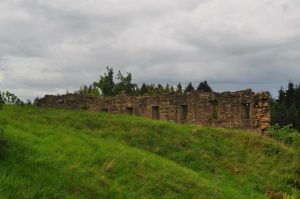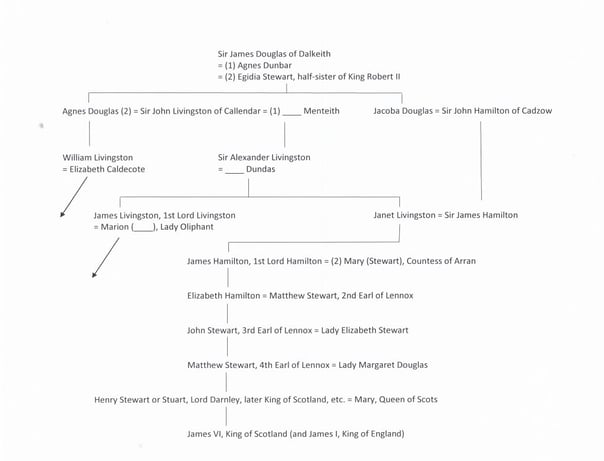In reviewing some late fourteenth- and early fifteenth-century marriages in the Livingston family in Scotland, I was struck by a pair of alliances that must have been important to the Livingstons of that era. This review also underlined my impression that the records of that period – and the later accounts based on those records – can be a challenge, since all too often the compilers shrug and offer “(?) daughter of ______ Somebody of Somewhere” by way of identification.
The fourteenth-century Livingston family, which would achieve national prominence during the next century, was clearly a rising clan, interested in marrying into established families. The marriage of Sir William Livingston (d. 1364) to the heiress of Callendar in Stirlingshire – descended, somehow, from the feudal Earls of Lennox – was an important match, while in the next generation his son Sir John Livingston (d. 1402) married twice. Sir John’s first wife was an unnamed daughter of John Menteith of Kerse, Renfrewshire, kin to the High Stewards of Scotland (and from 1371 the Stewart Kings of Scotland). For his second wife, Sir John made a curious match – at least from our vantage point.
In a contract dated 15 August 1381, Sir John – a man of adult years – married Agnes Douglas, (the elder?) daughter of Sir James Douglas of Dalkeith, Midlothianshire, and his first wife Agnes Dunbar, who married about 1372! Agnes Douglas was not her father’s heiress – she had brothers and a sister – but in marrying her Livingston was allying himself with more powerful families, as Agnes’s stepmother was Egidia Stewart, the half-sister of King Robert II, who must have been older than Sir James (and old enough to be Agnes’s grandmother).[1]
Sir John Livingston had children by both wives, and the Livingston family in America descends from both families: the son and heir, Sir Alexander Livingston (d. 1450), was by the first wife, William Livingston of Kilsyth, Lanarkshire (d. before 1460) by the second. Given Agnes’s age at marriage, it is likely that her children were born in the 1380s or ‘90s.
Her sister, Jacoba (or Janet) Douglas, made another interesting marriage, to Sir John Hamilton of Cadzow, Lanarkshire. They were married by 8 November 1388, some years after Agnes married Sir John Livingston, and they presumably had children starting about 1390.[2]
He reached the heights of power during the minority of King James II – for a few years, the Livingstons were ubiquitous – then fell as far, or further...
Agnes Douglas’s stepson, Sir Alexander Livingston, would become an important figure in fifteenth-century Scotland. He reached the heights of power during the minority of King James II – for a few years, the Livingstons were ubiquitous – then fell as far, or further; he survived one son, Alexander Livingston of Phildes (in Stirlingshire), another ancestor of the American Livingston family, who was executed in the winter of 1449/50.[3]
Sir Alexander’s children – from his marriage to a daughter of “Dundas of Dundas,” Lothianshire – were old enough to marry in the 1410s and early ‘20s, and one of them, Janet Livingston, married her connection Sir James Hamilton of Cadzow,[4] son and heir of Sir John Hamilton and Jacoba Douglas. As the Livingstons’ star rose, so did the Hamiltons': Janet’s son James was created Lord Hamilton in the palmy days of his grandfather’s power. This Lord Hamilton neatly sidestepped the coming calamity that engulfed the Livingstons and, in due course, married Mary (Stewart), Countess of Arran, the daughter of King James II – the monarch who, as a child, had been in the power of the Livingstons.
It was thanks to this Hamilton-Stewart marriage that the Hamiltons remained close to the Scottish throne through the fifteenth and sixteenth centuries: because the throne passed from one child king or queen to another, a succession of Hamiltons played outsized parts in Scottish politics as the nearest adult heirs.
Finally, a descendant reached the uneasy apogee of power, when Henry Stewart, Lord Darnley, descended from the 1st Lord Hamilton (and thus Sir Alexander Livingston and Sir James Douglas), married his cousin Mary, Queen of Scots. This glamorous marriage ended badly, but it resulted in the birth of the future King James VI of Scotland (and I of England).
The Livingstons of Callendar were well aware of their grand Hamilton and Stewart cousins throughout the sixteenth century. Family connections of this sort, after all, were the purpose of those arranged marriages of previous generations … even if, as in the case of more than one Livingston, Douglas, and Hamilton, that promised access to power ended on the executioner’s block.
Notes
[1] Sir James Balfour Paul, ed., The Scots Peerage, 9 vols. (Edinburgh, 1904–11), 5: 424–26, 6: 344–48.
[2] Ibid., 5: 426, 6: 349.
[3] Ibid., 5: 429.
[4] This marriage took place before 20 October 1422. Ibid., 4: 348, 352–53, 5: 429.
Share this:
About Scott C. Steward
Scott C. Steward has been NEHGS’ Editor-in-Chief since 2013. He is the author, co-author, or editor of genealogies of the Ayer, Le Roy, Lowell, Saltonstall, Thorndike, and Winthrop families. His articles have appeared in The New England Historical and Genealogical Register, NEXUS, New England Ancestors, American Ancestors, and The Pennsylvania Genealogical Magazine, and he has written book reviews for the Register, The New York Genealogical and Biographical Record, and the National Genealogical Society Quarterly.View all posts by Scott C. Steward →

